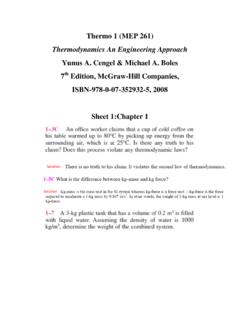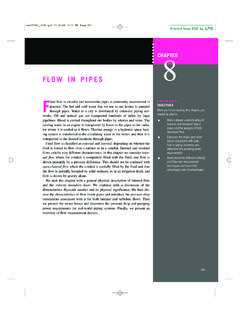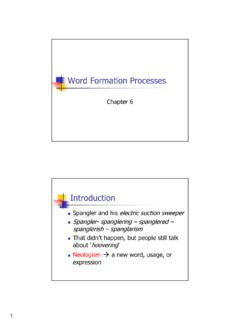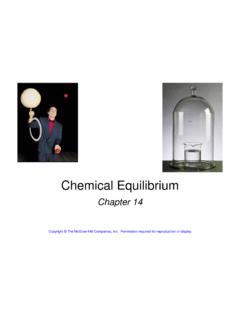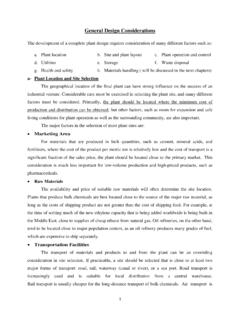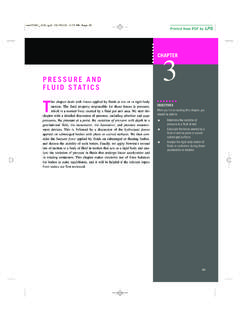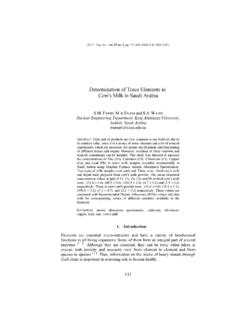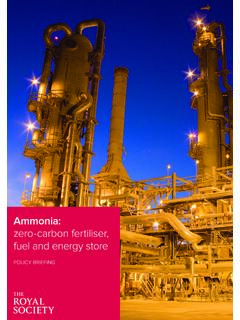Transcription of FLOW IN PIPES - kau
1 FLOW IN PIPESF luid flow in circular and noncircular PIPES is commonly encountered inpractice. The hot and cold water that we use in our homes is pumpedthrough PIPES . Water in a city is distributed by extensive piping net-works. Oil and natural gas are transported hundreds of miles by largepipelines. Blood is carried throughout our bodies by arteries and veins. Thecooling water in an engine is transported by hoses to the PIPES in the radia-tor where it is cooled as it flows. Thermal energy in a hydronic space heat-ing system is transferred to the circulating water in the boiler, and then it istransported to the desired locations through flow is classified as externaland internal,depending on whether thefluid is forced to flow over a surface or in a conduit.
2 Internal and externalflows exhibit very different characteristics. In this chapter we consider inter-nal flowwhere the conduit is completely filled with the fluid, and flow isdriven primarily by a pressure difference. This should not be confused withopen-channel flowwhere the conduit is partially filled by the fluid and thusthe flow is partially bounded by solid surfaces, as in an irrigation ditch, andflow is driven by gravity start this chapter with a general physical description of internal flowand the velocity boundary continue with a discussion of thedimensionless Reynolds numberand its physical significance.
3 We then dis-cuss the characteristics of flow inside PIPES and introduce the pressure dropcorrelations associated with it for both laminar and turbulent flows. Thenwe present the minor losses and determine the pressure drop and pumpingpower requirements for real-world piping systems. Finally, we present anoverview of flow measurement you finish reading this chapter, youshould be able to Have a deeper understanding oflaminar and turbulent flow inpipes and the analysis of fullydeveloped flow Calculate the major and minorlosses associated with pipe flow in piping networks anddetermine the pumping powerrequirements Understand the different velocityand flow rate measurementtechniques and learn theiradvantages and 11/4/04 7:13 PM Page 3218 1 INTRODUCTIONL iquid or gas flow through pipesor ductsis commonly used in heating andcooling applications and fluid distribution networks.
4 The fluid in such appli-cations is usually forced to flow by a fan or pump through a flow pay particular attention to friction,which is directly related to the pres-sure dropand head lossduring flow through PIPES and ducts. The pressuredrop is then used to determine the pumping power requirement. A typicalpiping system involves PIPES of different diameters connected to each otherby various fittings or elbows to route the fluid, valves to control the flowrate, and pumps to pressurize the terms pipe, duct,and conduitare usually used interchangeably forflow sections. In general, flow sections of circular cross section are referredto as PIPES (especially when the fluid is a liquid), and flow sections of non-circular cross section as ducts(especially when the fluid is a gas).
5 Small-diameter PIPES are usually referred to as this uncertainty, wewill use more descriptive phrases (such as a circular pipeor a rectangularduct) whenever necessary to avoid any have probably noticed that most fluids, especially liquids, are trans-ported in circular is because PIPES with a circular cross sectioncan withstand large pressure differences between the inside and the outsidewithout undergoing significant distortion. Noncircular pipesare usuallyused in applications such as the heating and cooling systems of buildingswhere the pressure difference is relatively small, the manufacturing andinstallation costs are lower, and the available space is limited for ductwork(Fig.)
6 8 1).Although the theory of fluid flow is reasonably well understood, theoreti-cal solutions are obtained only for a few simple cases such as fully devel-oped laminar flow in a circular pipe. Therefore, we must rely on experimen-tal results and empirical relations for most fluid flow problems rather thanclosed-form analytical solutions. Noting that the experimental results areobtained under carefully controlled laboratory conditions and that no twosystems are exactly alike, we must not be so naive as to view the resultsobtained as exact. An error of 10 percent (or more) in friction factors cal-culated using the relations in this chapter is the norm rather than the exception.
7 The fluid velocity in a pipe changes from zeroat the surface because ofthe no-slip condition to a maximum at the pipe center. In fluid flow, it isconvenient to work with an averagevelocity Vavg, which remains constant inincompressible flow when the cross-sectional area of the pipe is constant(Fig. 8 2). The average velocity in heating and cooling applications maychange somewhat because of changes in density with temperature. But, inpractice, we evaluate the fluid properties at some average temperature andtreat them as constants. The convenience of working with constant proper-ties usually more than justifies the slight loss in , the friction between the fluid particles in a pipe does cause a slightrise in fluid temperature as a result of the mechanical energy being con-verted to sensible thermal energy.
8 But this temperature rise due to frictionalheatingis usually too small to warrant any consideration in calculations andthus is disregarded. For example, in the absence of any heat transfer, no322 FLUID MECHANICSC ircular pipeRectangularductWater50 atmFIGURE 8 1 Circular PIPES can withstand largepressure differences between theinside and the outside withoutundergoing any significant distortion,but noncircular PIPES 8 2 Average velocity Vavgis defined as theaverage speed through a cross fully developed laminar pipe flow,Vavgis half of maximum 11/4/04 7:13 PM Page 322noticeable difference can be detected between the inlet and outlet tempera-tures of water flowing in a pipe.
9 The primary consequence of friction influid flow is pressure drop, and thus any significant temperature change inthe fluid is due to heat value of the average velocity Vavgat some streamwise cross-section isdetermined from the requirement that the conservation of massprinciple besatisfied (Fig. 8 2). That is,(8 1)where the mass flow rate,ris the density,Acis the cross-sectional area,and u(r) is the velocity profile. Then the average velocity for incompressibleflow in a circular pipe of radius Rcan be expressed as(8 2)Therefore, when we know the flow rate or the velocity profile, the averagevelocity can be determined 2 LAMINAR AND TURBULENT FLOWSIf you have been around smokers, you probably noticed that the cigarettesmoke rises in a smooth plume for the first few centimeters and then startsfluctuating randomly in all directions as it continues its rise.
10 Other plumesbehave similarly (Fig. 8 3). Likewise, a careful inspection of flow in a pipereveals that the fluid flow is streamlined at low velocities but turns chaoticas the velocity is increased above a critical value, as shown in Fig. 8 4. Theflow regime in the first case is said to be laminar,characterized by smoothstreamlinesand highly ordered motion,and turbulentin the second case,where it is characterized by velocity fluctuationsand highly transitionfrom laminar to turbulent flow does not occur sud-denly; rather, it occurs over some region in which the flow fluctuatesbetween laminar and turbulent flows before it becomes fully turbulent.
